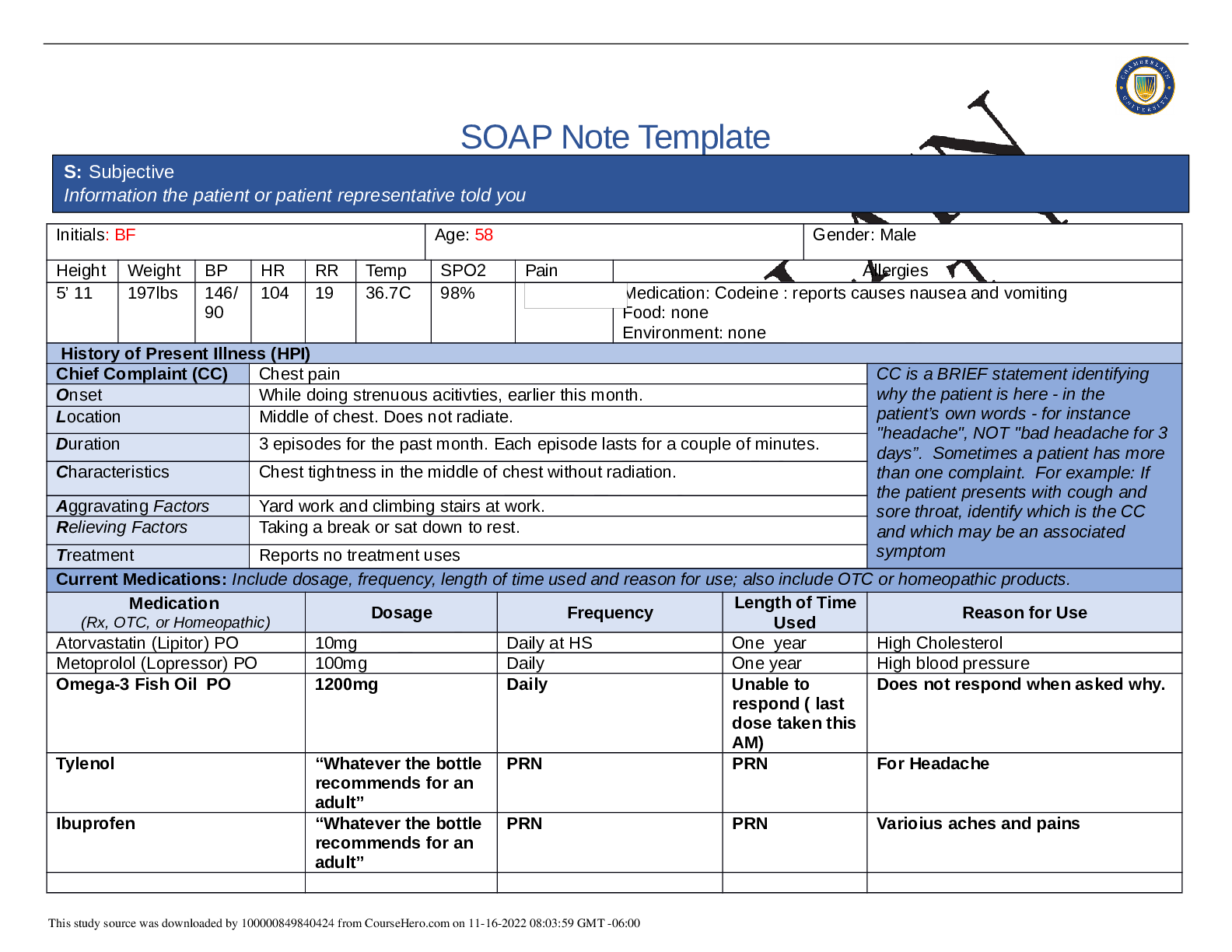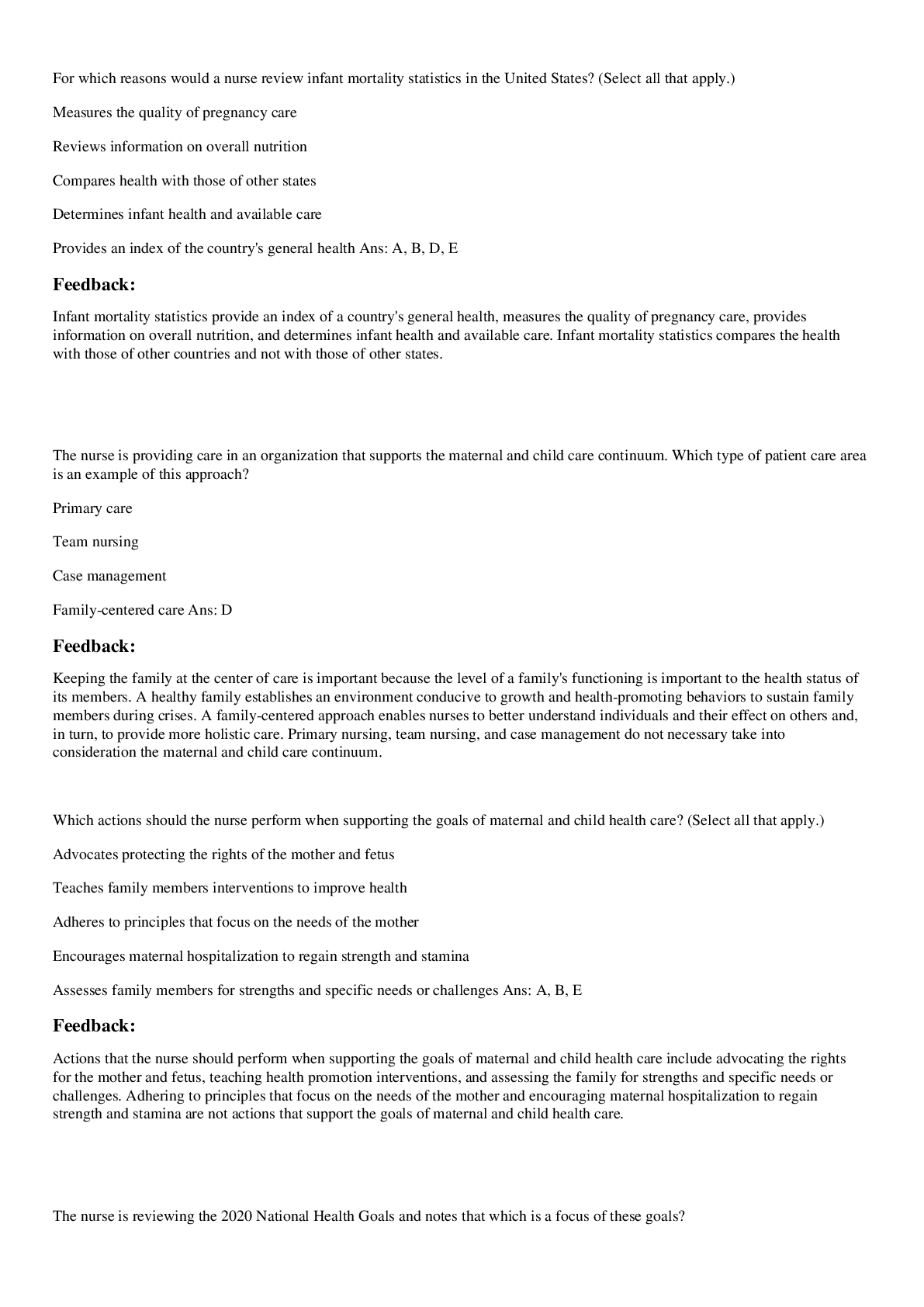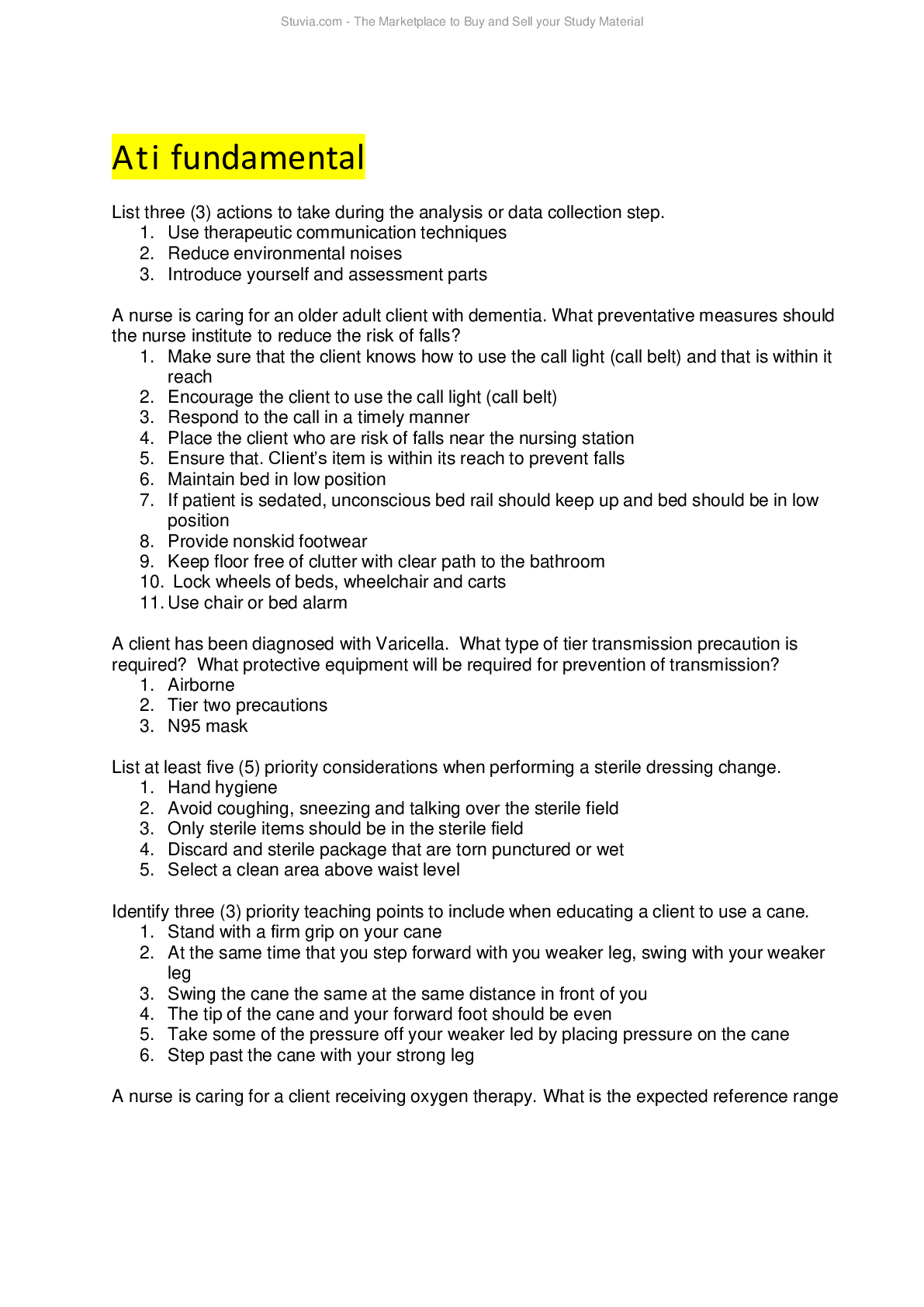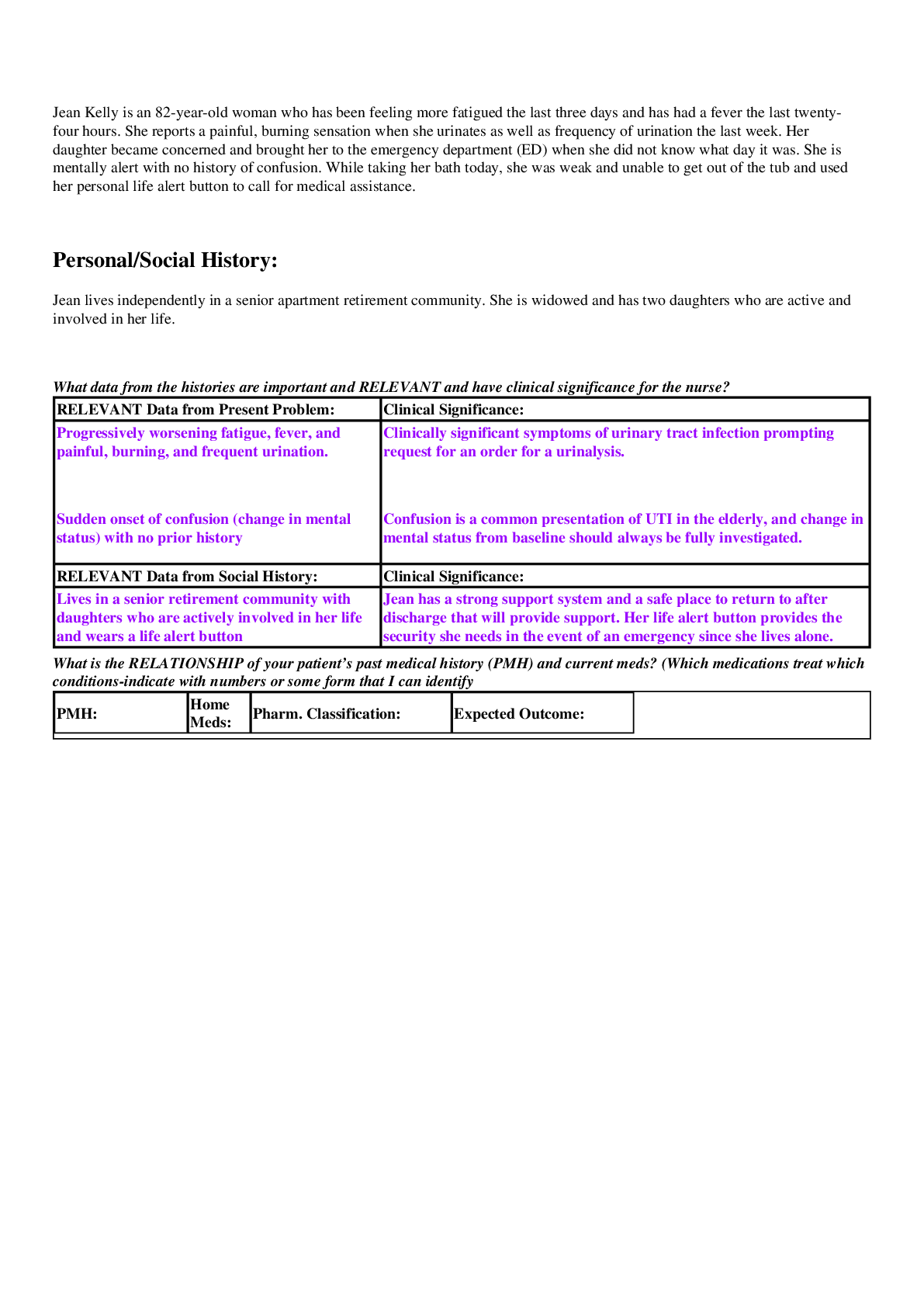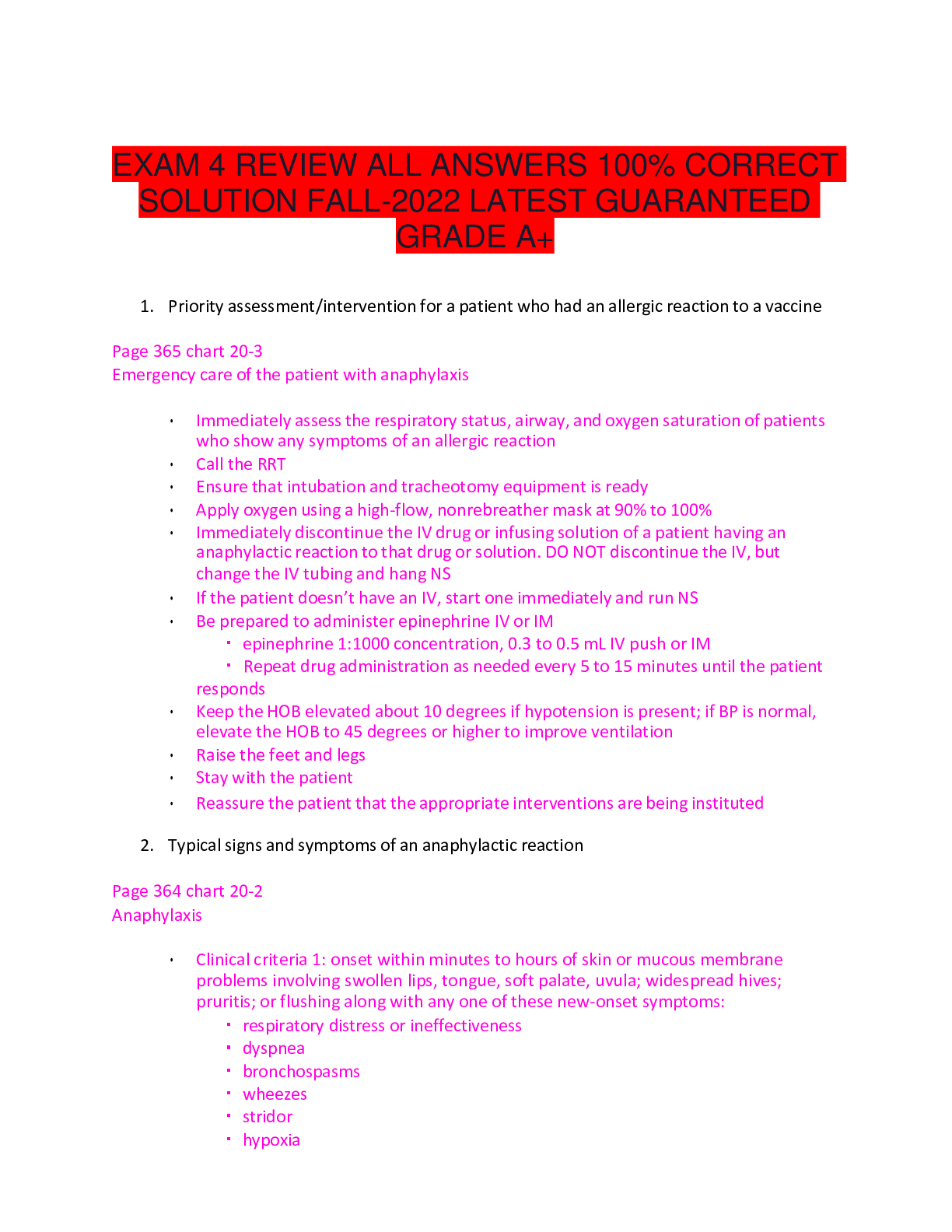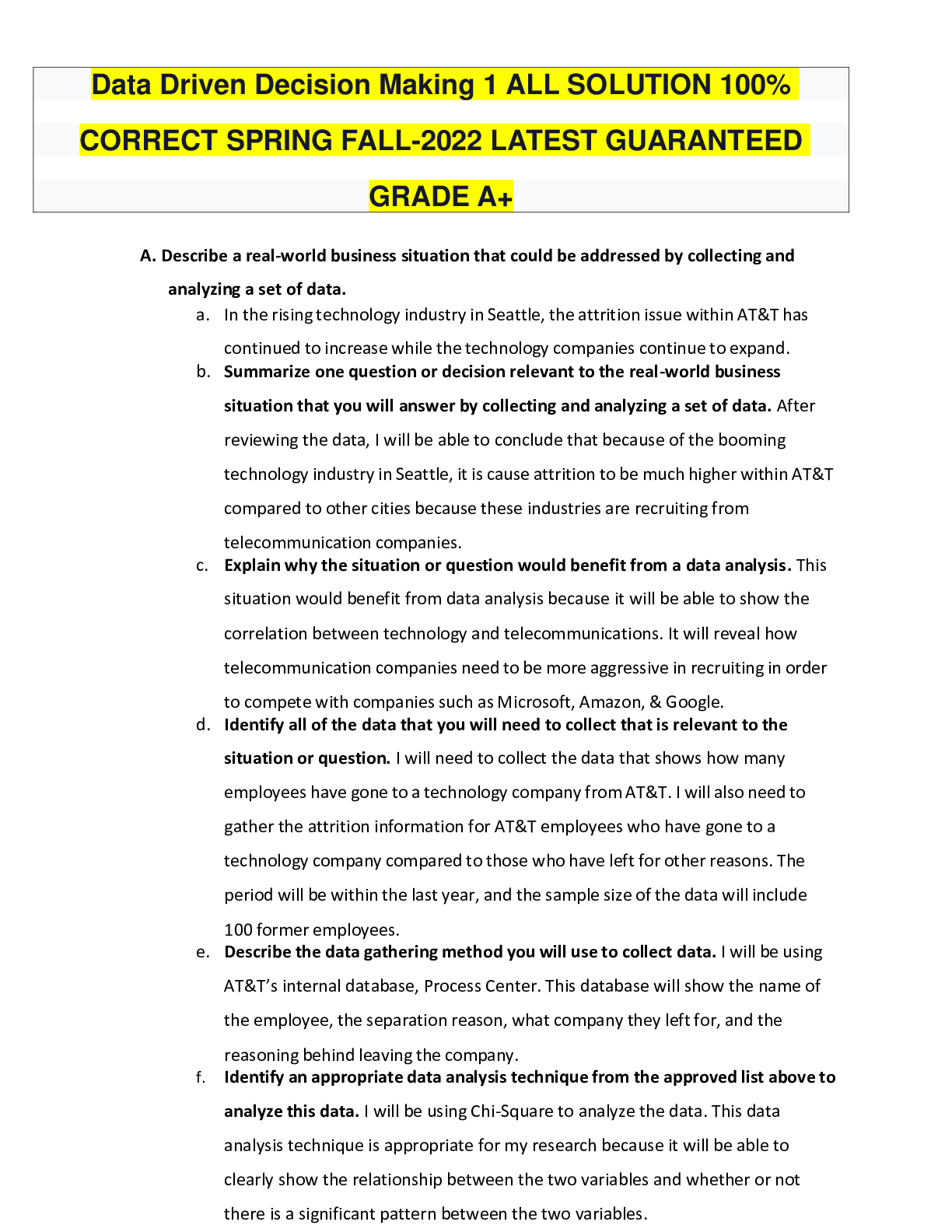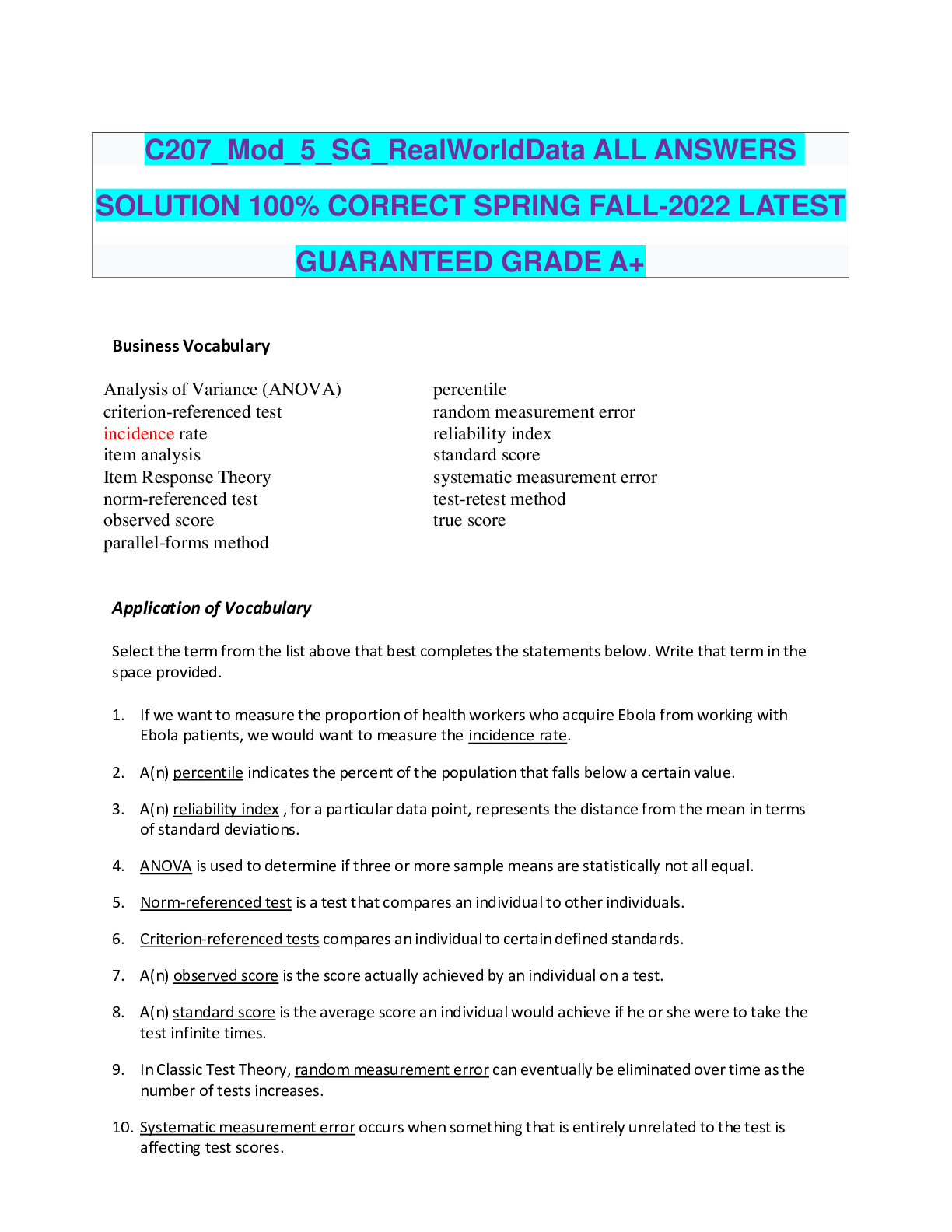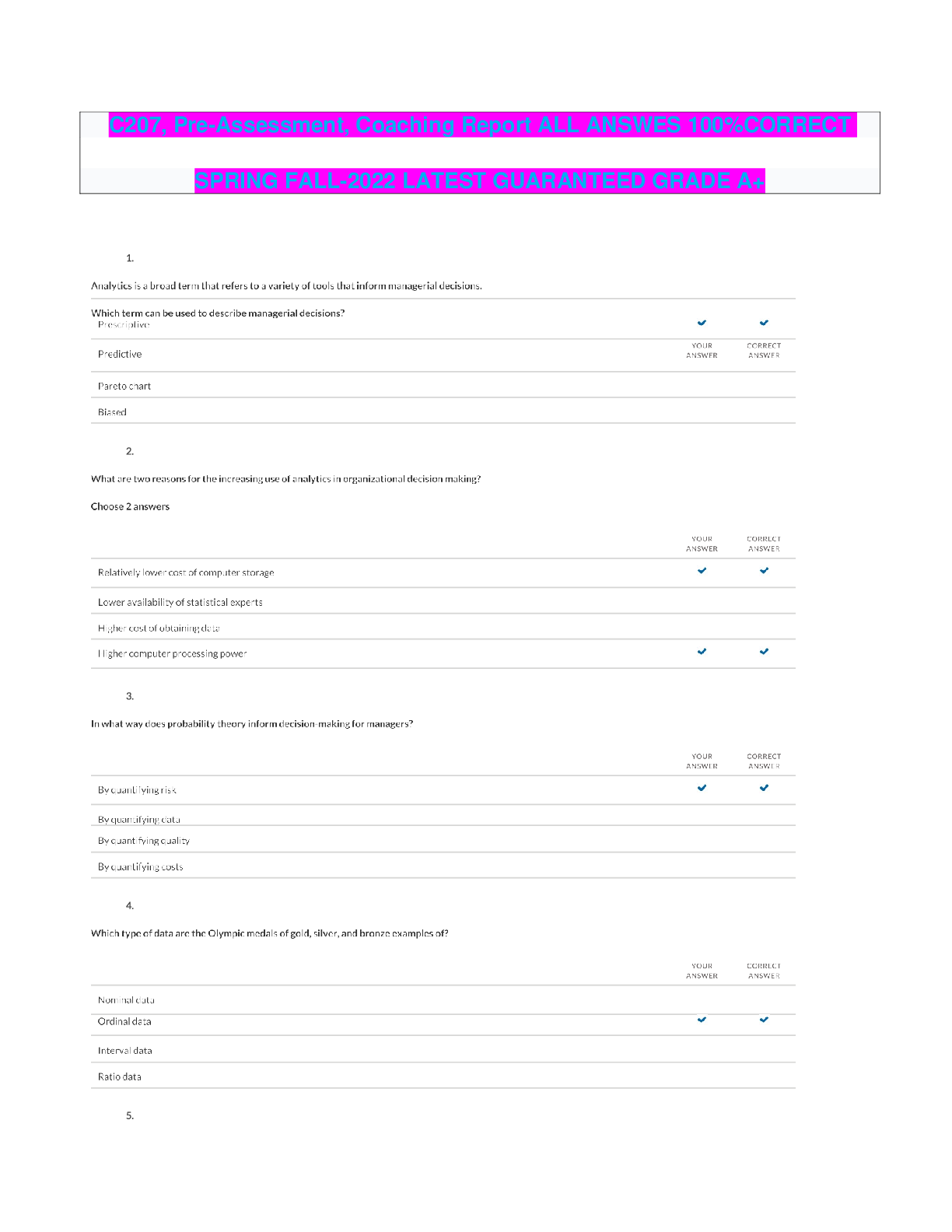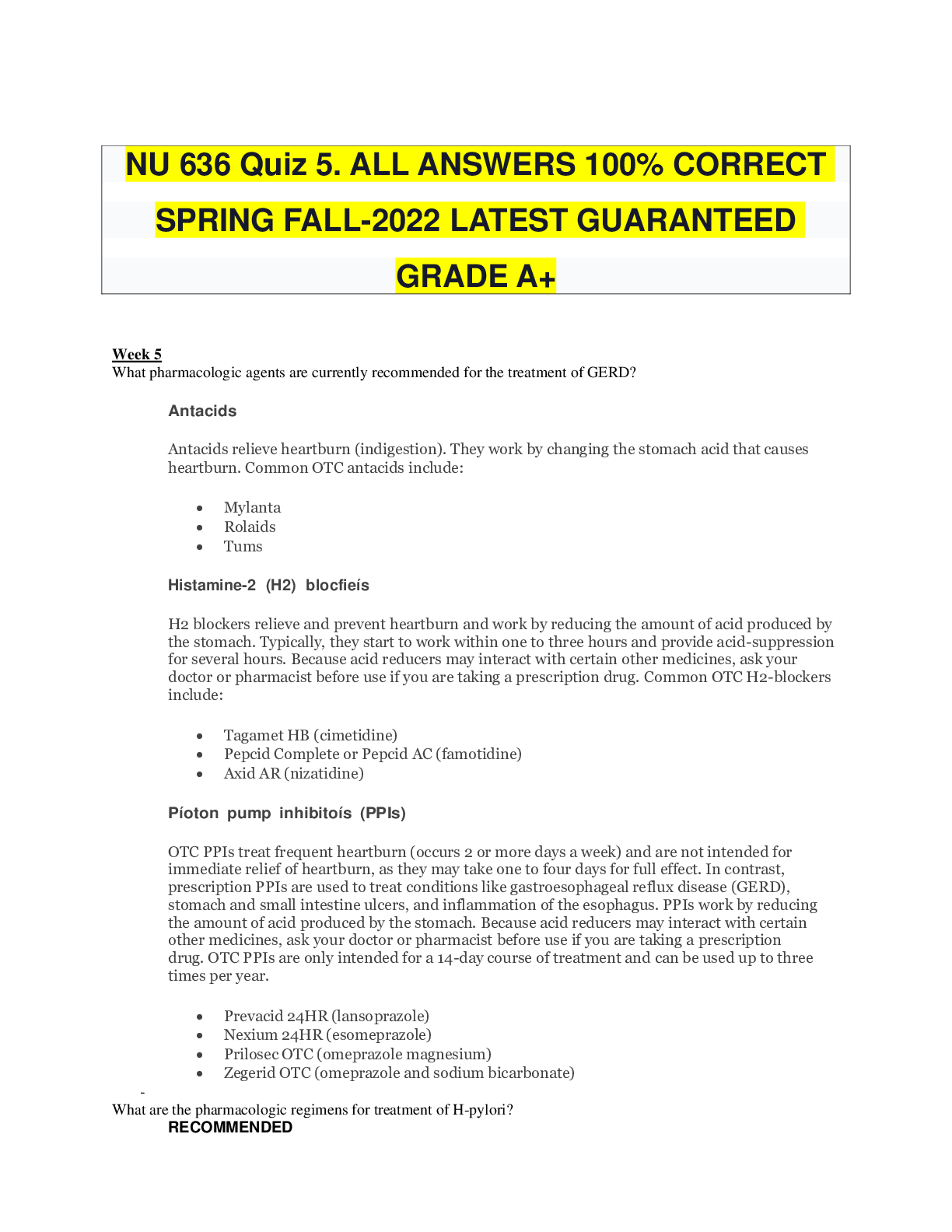*NURSING > QUESTIONS and ANSWERS > ATI Teas 6 All Subjects Covered: EVERYTHING YOU NEED ALL SOLUTION & ANSWERS 100% CORRECT SPRING FALL (All)
ATI Teas 6 All Subjects Covered: EVERYTHING YOU NEED ALL SOLUTION & ANSWERS 100% CORRECT SPRING FALL-2022 LATEST GUARANTEED GRADE A+
Document Content and Description Below
Anatomy: is what you see with your eyes in the human body. Microscopic Anatomy: examines cells and molecules. Cytology: study of cells. Histology: study of tissues. Physiology: is the ... study of functions of anatomical structures. *Smallest living is a CELL. *Smallest organisms is a ATOM. Levels of Hierarchy Atom- the most basic complete unit of an element. Molecule- a group of atoms bonded together, representing the smallest fundamental unit of a chemical compound that can take part in a chemical reaction. Organelles- are cells parts that function within a cell. Cells- the basic structural unit of an organism from which living things created. Is one individual cell. Tissues- a group of cells with similar structure that functions together as a unit, but at a lower level than organs. Organ- a self contained part of an organism that performs specific functions. Is formed by two or more similar tissues. Organ System- functional groups of organs that work together within the body: circulatory, integumentary, skeletal, reproductive, digestive, urinary, respiratory, endocrine, lymphatic, muscular and nervous. Humans have 11 Organ Systems. Cells Structure • Nucleus - holds the cells DNA in form of chromatin • Ribosomes- small structures that build proteins “amino acids”. • Golgi Apparatus- modifies and packages proteins secreted from cell. • Vacuoles - storage, digestion and waste removal. • Cytoskeletal- series of rod shaped proteins that provide shape/support cell. • Microtubules - part of the cytoskeletal. • Cytosol - liquid material in cell. • Cell membrane - separate internal and external cellular environment allows material to enter and exit cell. • Endoplasmic Reticulum- smooth or rough transport system of the cell. • Mitochondria- generates ATP powerhouse of the cell. ATP production is called cellular respiration Animal Cells Centrosome- pairs of centrioles involved in mitosis. Centriole- cylinders involved in cellular division. Lysosomes- the purpose of the lysosome is to digest things. They might be used to digest food or break down the cell when it dies. Cilia- cause cell to move. Flagella- whip tail to move cell. TISSUES: Group of CELLS. Muscle, Nerve, Epithelial, Connective. 1. Epithelial: (joined together tightly) Example. Skin 2. Connective: (dense, loose, or fatty) Example. Tissue, Cartilage, Tendons, Ligaments, Fat, Blood, Lymph. It protects and binds body parts. a. Cartilage: cushions and provides structural support Fibrous b. Blood: transport oxygen to cells and removes waste. Also carries hormones and defends against disease. c. Bone: (hard) produces red blood cells 3. Muscle: supports and move body Smooth Cardiac Skeletal 4. Nervous: Example. Brain, spinal cord, and nerves. Neurons: control responses to changes in environment. Mitosis - it has 4 phases. Pink MAT / Prophase, Metaphase, Anaphase, Telophase Interphase - Cell prepares for division by replicating genetic/cytoplasmic material. Prophase - Chromatin thickens into chromosomes and the nuclear membrane begins to disintegrate. Pairs of centrioles move to opposite sides of cell and spindle fibers form. Metaphase - Spindle moves to center of cell and chromosome pairs align along center of spindle structure. Anaphase - Chromosome pairs pull apart into daughter chromosomes. Telophase - Spindle disintegrates, nuclear membrane reforms or is pinched. Cytokinesis - Physical splitting of cell. Meiosis- same as mitosis except happens twice, results in four daughter cells instead of two. Mature haploid male and female germ cell uniting in sexual reproduction. Gametes in female = Egg Gametes in Male = Sperm Meiosis is when gametes produce a zygote. Zygote: controls cell differentiation. It forms during fertilization. The cells from each parent that combine to form a zygote are called gametes. Zygote is the first stage of reproduction. 1. Respiratory System main functions are the critical tasks of transporting oxygen from the atmosphere into the body’s cell and moving carbon dioxide in the other direction. Nasal Cavity - air passage that warms, moistens, and filters air, and also contains olfactory receptors. Medially divided by the nasal septum. External Nares - the visible ‘nostrils’ that are the entrances into the nasal cavity The Larynx - air passage that connects the pharynx to the trachea, composed of individual cartilages, mostly hyaline. Commonly called the voice box for its additional function of voice production. Epiglottis - the only elastic cartilage, blocks entrance to the larynx during swallowing, ensuring food only enters the esophagus. Lungs - Paired organs that are highly compartmentalized into small air sacs called alveoli. Also contain elastic tissue to facilitate ventilation. Alveoli – the individual lung compartments where gas exchange with blood occurs. Type 2 cells - cuboidal cells that secrete surfactant, which reduces the surface tension of water to prevent alveolar collapse. Bronchi – the main passageways directly attached to the lungs. Bronchioles- small passages in the lungs that connect bronchi to alveoli Right Lung - divided into upper, middle, and lower lobes by the horizontal fissure and oblique fissure respectively. Left Lung - divided into upper and lower lobes by the oblique fissure, also has the cardiac notch – an indentation for the heart’s apex. The Pleurae - a double layer of serous membrane producing serous fluid to reduce friction during lung ventilation/movement. • Visceral pleura - the serous membrane layer that clings to the lung surface. • Parietal pleura - the serous membrane that is separated from the lungs, clings to the internal surface of the thoracic body wall. • Pleural cavity - the space between the parietal and visceral layers filled with serous fluid, which reduces friction and causes pleural membranes to stick together. Perfusion- The passage of fluid to an organ or a tissue. Pulmonary Ventilation - the movement of air into and out of the lungs based on the interactions of pressures in and around the body. • Inspiration - the movement of air into the lungs. • Expiration - the movement of air out of the lungs. Tidal volume - The volume of air ventilated during resting breathing. Inspiratory reserve volume - additional air that can be forcefully inhaled beyond tidal. Expiratory reserve volume - additional air that can be forcefully exhaled beyond tidal. Residual volume - volume of air always in lungs, prevents lung collapse. Medulla Oblongata- the breathing control centers of the medulla oblongata of the brainstem control respiration through monitoring carbon dioxide levels of blood pH. Asthma- A lung disease characterized by inflamed narrowed airways and difficulty breathing. Cystic Fibrosis – A genetic disorder affects the lungs and other organs characterized by difficulty breathing coughing up sputum and lung infections. 2. Cardiovascular System Heart • Location- in the mediastinum of thoracic cavity. • Function- generates pressure to pump blood through circulatory system • Orientation- flat base is directed toward higher right shoulder, and pointed apex points to left hip. Heart Coverings • Pericardium- the two-layered membranous sac in which the heart sits. Heart Layers [Show More]
Last updated: 2 years ago
Preview 1 out of 44 pages

Buy this document to get the full access instantly
Instant Download Access after purchase
Buy NowInstant download
We Accept:

Reviews( 0 )
$8.50
Can't find what you want? Try our AI powered Search
Document information
Connected school, study & course
About the document
Uploaded On
May 19, 2022
Number of pages
44
Written in
Additional information
This document has been written for:
Uploaded
May 19, 2022
Downloads
0
Views
83





